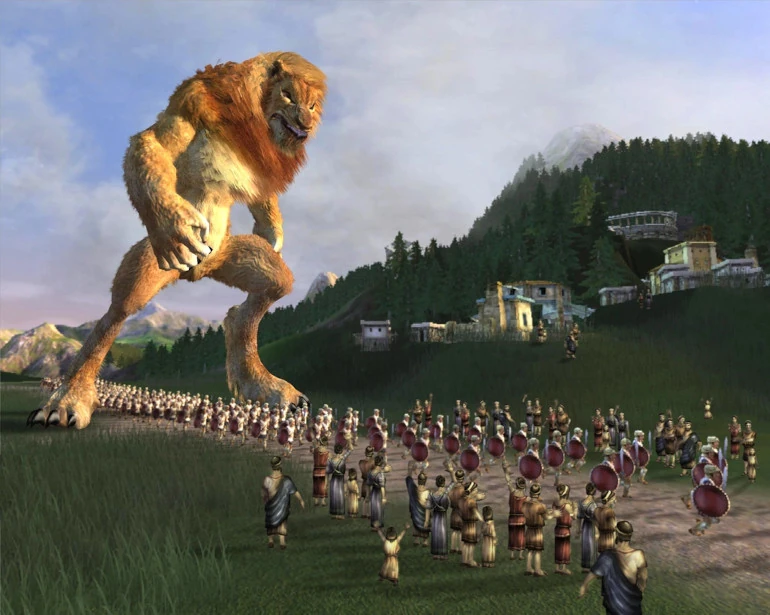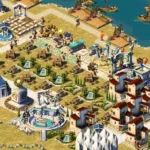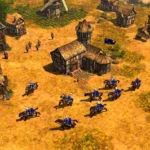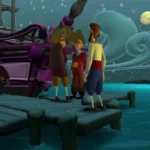Black & White 1 – PC Review

Black & White: When people pray, begging for the help of a higher being whose strength and knowledge surpass all human capability, a new god is born. A god who can turn day into night and night into day. A power beyond human imagination. A power like the one you will possess.
In Black & White, there are vengeful gods, evil divine creations, acts of compassion, and moments of rage where lands are devastated by terrible floods—leaving only a chosen few alive. Someone has prayed for you to save their child’s life, but that doesn’t mean you have to be kind to the humans who worship your divinity. They give you your power, but as any good god knows, humans are just puppets, easy to control.
Black & White’s Gameplay
Before diving in, we need to sort out a few things about Black & White—in other words, if I don’t organize this, you won’t understand a thing.
The Beginning of Black & White
A village—the only one under your influence—blindly believes in you and your immense power to either help them or plunge them into absolute chaos. Little by little, we’ll learn our abilities as an all-powerful god.
We’ll pick up a rock and practice our aim against other stones (like in a classic American bowling alley). But we don’t have to use rocks—we can throw humans at them and watch the villagers tremble in fear at our cruelty. What does this mean? Simple. The first steps are the most important (though not the only ones) in defining our godly personality—whether we serve chaos or order.
The Village
They’re the ones who created us in Black & White. If they stop believing in us, we’ll fade away as if we never existed. That means that to earn their "devout and faithful belief," we can either give them all the comforts they need (protection, food, houses, and wood) or make them so terrified of us that they can’t imagine worshipping another god (achieved by throwing lightning bolts, fireballs, or snatching a villager from the nursery to sacrifice at our temple’s power gate).
However, we must remember that if the villagers’ needs in Black & White grow too high, we’ll become weak against our enemies. To put it simply: The only way to progress in Black & White is by taking control of villages under another god’s influence. To do this, we must either give them everything they need or scare them so much they can’t even think of another god. It’s a double-edged sword that can determine the success or failure of our "divine" mission in the world of Black & White.
The Creature
Possibly the most complex and expansive aspect of Black & White. Imagine having a cat with the intelligence of a monkey and the strength of a colossus. Could you train it? Of course you could—in this game, you’re an all-powerful god.
At the start of Black & White, we can choose between a cow, a supposed "red gorilla?" and a tiger. Each creature has different intelligence levels and abilities. The tiger fights like no other, the cow has "kindly" tendencies, and the monkey has the smarts to learn things faster.
How do you teach it things?
Let me give you an example. You switch to follow mode (or press C to go where it is). You see it approach a villager and grab them. That’s when you must interact—either scratch its belly (it’ll eat the villager and start snacking on others when hungry) or give it a little tap on the feet (it’ll let go and do no harm). These actions shape the creature’s behavior.
But that doesn’t mean it’s completely robotic. On the contrary, it can make its own decisions based on consequences—but early on, it’s crucial to keep an eye on it, or it’ll turn into a capricious beast that escapes your "divine control" and becomes the worst plague on your land.
There’s also something called the "leash," which is vital for proper training. With it, we can set its range of movement (tying it to a tree and shortening the rope), order it to go to a specific spot (it might listen), or tell it to pick up something and drop it somewhere else.
This leash isn’t just a training tool—it’s essential for teaching the creature the one-time-use miracles we’ll find in Black & White’s first map. I recommend staying there as long as needed to teach your creature every available miracle while you learn their uses and how to get the most out of them.
The Miracles
In Black & White, there are many kinds—from essential ones (food, wood, healing, rain, miracle forests, and more) to basic chaos-inducing spells (fireballs, meteor showers, or lightning strikes). As I mentioned earlier, our creature can learn these miracles—but don’t expect it to cast a spell after seeing it just once. It’ll need to witness it three to five times before replicating it.
But miracles aren’t free. To perform them, you need power, which is gained in two ways:
- Villagers praying and jumping around your energy sources (or "mana," if you prefer).
- Sacrificing living beings (animals or plants) at the altar.
If we’re good trainers, we can make our creature perform sacrifices for us—but it’ll take time before it does it automatically. Otherwise, you won’t get far in Black & White.
Conquest
Starting from Black & White’s second world (let’s call it "Level 2"), we’ll see what being a god is really about. Our mission is simple—but not easy. We must conquer the souls of other villages’ inhabitants, making them believe only in us.
That means impressing them—showing off our power by giving them food, sending our creature to awe them, or simply watering their fields so crops grow endlessly. With patience, we’ll take control of enemy villages until we erase all traces of the rival god trying to "wipe us off the map."
In Black & White, conquest can be done in many ways—sending missionaries to spread our influence, placing our creature in the village square with the "leash of kindness," or, if all else fails, giving them everything they need.
Controls
At first, moving around the map feels chaotic—whether searching for adventure or just tracking your creature. But that’s only at the start. Later, we’ll learn to set quick shortcuts, locate the creature by pressing C, or switch training leashes with V and B.
So is it good or bad?
It’s very good—responsive to our commands and lets us move quickly. For that, we have the basic training at the game’s start or, if needed, the Gods’ Playground (accessible anytime by pressing F2 without losing progress).
Graphics
Exceptionally well done. The terrain textures are detailed, physical collisions feel realistic, and fire, shield, and rain effects are impressive. The day-night cycle is stunning, the sky is spectacular, and every detail adds realism without losing the game’s ever-present humor.
When you see your creature breakdancing with villagers, you’ll understand—but you’ll have to see it to believe it. It’s mind-blowing.
Music & Sound Effects
The music is a pleasant mix between an Enya album and the latest New Age trends, with rhythmic touches inspired by Inca, Chinese, or Celtic styles. Sound effects are just as well-crafted—from the crackle of burning buildings to birds (or crows) fluttering over villagers’ heads.
Most importantly, all voices and texts are fully localized in Spanish—and they did a fantastic job.
Gameplay
Conclusion
We’re looking at a game that will delight any player—from those who love micromanaging every aspect of Black & White and crafting new strategies, to those who just want to have fun training one of the best virtual pets I’ve seen in a long time.
It’s fun, full of laugh-out-loud moments, situations where you won’t know what to do, and times when a villager’s life or death rests on your choices. Remember—being a god doesn’t mean you have to be good and loving. You can also bring destruction and evil. Here, you decide.
 Max Payne 1 – When You Have Nothing Left to Lose
Max Payne 1 – When You Have Nothing Left to Lose Commandos 2 – A Timeless Classic
Commandos 2 – A Timeless Classic Zeus: Master of Olympus – The God with a Trident
Zeus: Master of Olympus – The God with a Trident Deus Ex: A Masterpiece of Storytelling, Characters, and Action
Deus Ex: A Masterpiece of Storytelling, Characters, and Action Age of Empires 2: Building Empires in the Medieval Era
Age of Empires 2: Building Empires in the Medieval Era Diablo 2: Lord of Destruction - A New Era of Darkness
Diablo 2: Lord of Destruction - A New Era of Darkness 5 Video Games to Play God
5 Video Games to Play God Escape from Monkey Island – PC Review
Escape from Monkey Island – PC Review
![[Speedrun] Black & White Any% in 49:01 [RTA/Single-Segment]](https://i.ytimg.com/vi/Yws1GA483yo/hqdefault.jpg)
Leave a Reply